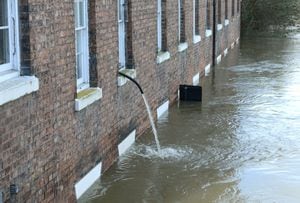Letter: Not in favour of dams to resolve flooding problem
Mike Cockett (Letters, February 29) rightly highlights climate change as the driver behind our recent flooding; he also is correct to assert that this is only a taste of things to come.

The Shrewsbury Level 2 flood risk assessment, published by Shropshire Council, suggests that what we have just experienced was anticipated to be a 1 in 100 year event; these forecasts were published in 2017.
Mr Cockett and others, including MP Daniel Kawcyznski, understandably want to prevent repeats, arguing for dams to control flooding. MP Owen Patterson and others, including myself, argue strongly against dams, and in favour of a broader land-management based solution.
We must first understand where our floods come from. The Severn’s catchment is primarily in Wales, where rain falls from moisture-laden Atlantic weather systems. Warmer air carries more moisture; climate change means more rain. We must look west for the source of our floods - once in the system, it will find its way to the sea, whether we like it or not.
Of course rain does not fall at a constant rate, quite the opposite. Consequently river flows go up and down, in the form of long (or short) waves, as the water level rises and falls. It is the size and shape of these waves which determine the degree of flooding, and it is this which we need to address if we are to prevent or at least minimise the risk of a repeat of last week. A longer, lower wave poses a far smaller risk of serious flooding.
Your readers may be aware that Llyn Clywedog in Wales was constructed in the 60’s to moderate the Severn’s flow by collecting rain in winter, releasing in summer. This keeps the water flowing, rather than controlling flooding, and works in the upland hills where its own catchment is small. Clywedog has a capacity of 50 billion litres, is 66 metres deep, and is roughly the size of the SY2 postcode.
Imagine the whole of SY2 flooded to a depth of a ten-storey building, and that is what the dams at Clywedog hold back. The peak river flow at Montford Bridge a few days ago would have filled Clywedog from empty in 116 days.
'Let rivers do what they do best'
Mr. Cockett’s solution of dams is in fact a misnomer. He would not be building dams, but reservoirs. Vast, land-eating reservoirs, requiring the sacrifice of fertile farmland (which floods have produced) as well as towns, villages, communities.
Furthermore, blocked rivers stop the flow of sediment; they silt up, reducing their flow capacity, making the problem worse. Rivers are naturally self-scouring, and naturally self-moderating flow-management systems. They do it counter-intuitively, by slowing flow and thus spreading out floodwater. How? Firstly, by storing massive quantities in the boggy uplands near the source. We have degraded that through drainage schemes and to an extent removal of natural tree cover.
Second, rivers self-manage by having flood plains, uneven river beds and courses, and fallen debris. All these create turbulence, slower flow, and a bit of space for letting off steam. We build unsuitable housing on floodplains, and call for dredging and channel straightening to ‘move the flow through’, which simply builds the water up to peak ramming speed downstream, as we saw last week, and which is laughably ineffective given the flow rates witnessed.
Intensive farming reduces soil absorption capacity, hence rain runs straight to rivers. Large areas of concrete and tarmac likewise prevent natural buffering of flow - instead of a sponge, our land becomes an impermeable sheet. Instead? Restoration of upland catchment ecologies to maximise storage capacity, through cross-border cooperation. Enforcement of proper building standards to ensure flood-resilient homes, especially on known flood risk areas. Work with farmers to reduce run-off and increase water retention. Let rivers do what they do best - carry water to the sea, naturally. A longer, lower flood wave will significantly reduce flood risk, improve the natural habitat, and be far cheaper than these huge, ‘something-must-be-done’ infrastructure white elephants.
Dan Shillabeer, MSc. Disaster Management & Resilience, Nesscliffe
Send us your letters for publication:
Email us at starmail@shropshirestar.co.uk or write to: Readers’ Letters, Shropshire Star, Ketley, Telford, TF1 5HU. Letters MUST include the writer’s name, address and telephone number. Letters will only be published anonymously in exceptional circumstances. The editor reserves the right to condense or amend letters.





